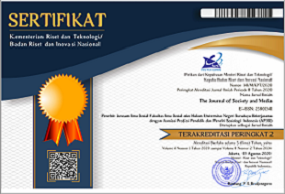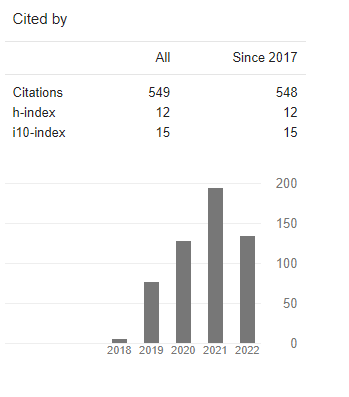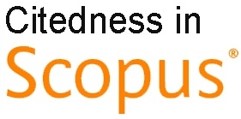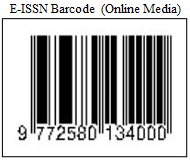The Influence Of Social Media On The Resilience Of Rural Communities During The Covid-19 Pandemic
DOI:
https://doi.org/10.26740/jsm.v5n2.p311-329Keywords:
social media, resilience, rural communities, covid-19Abstract
Indonesia is currently facing a new wave of COVID-19 transmission with the number of transmissions rising significantly. The community compliance factor is one of the important things in the spread of the Covid-19 rate. There needs to be intensive warning efforts, including campaigns through social media. This study aims to determine the effect of social media on the level of resilience in rural communities during the covid-19 pandemic. The research sample purposively amounted to 213 people from two research locations, namely Sambong Dukuh Village, Jombang Regency and Wonocoyo Village, Trenggalek Regency, Indonesia. The results showed that the p value = 0.001 < 0.05, which means that social media has a significant effect on the level of community resilience in dealing with the covid-19 pandemic. Furthermore, based on the R2 value, the result is 0.421, which means that social media has an influence on the community's resilience level of 42.1%, and the rest are other influences not examined in this study. Based on the results of the t test, it was found that the p value = 0.467 > 0.05, so it can be said that there is no significant difference between the level of resilience in the community in the two villages, even though the average value of Wonocoyo village is 77,393 better than Sambong Dukuh village of 77.00 , but the difference was not statistically significant. The researcher recommends the importance of further research on resilience based on regional characteristics.
References
Alisher, Mirzabaev. 2018. Improving the Resilience of Central Asian Agriculture to Weather Variability and Climate Change. Climate Smart Agriculture Building Resilience to Climate Change. United Nations: Food and Agriculture Organization
Arthur Huang & Melissa Farboudi Jahromi (2021) Resilience building in service firms during and post COVID-19, The Service Industries Journal, 41:1-2, 138-167, DOI: 10.1080/02642069.2020.1862092.
Brian Thiede (2016) Resilience and development among ultra-poor households and rural Ethiopia, Resilience, 4:1, 1-13, DOI: 10.1080/21693293.2015.1094166
Christopher, Mark Davis. (2021) Readiness and resilience of the health systems of the UK and Russia during Covid-19 epidemics in 2020-2021: impacts of priorities, shortages and rationing, Post-Communist Economies, 33:1, 1-63, DOI: 10.1080/14631377.2020.1867433.
CNN Indonesia. 2021. https://www.cnnindonesia.com/internasional/20210704094513-106-662927/kasus-covid-19-harian-ri-tertinggi-ketiga-di-dunia. Diakses pada tanggal 4 Juli 2021.
David A, Kerner and J. Scott Thomas. 2016. Ecological Resilience, Response to Climate Change. Chapter 3: Resilience Attributes of Social-Ecological Systems: Framing Metrics for Management. Oakville: Apple Academic Press, Inc.
Fiona H. Ashmore, John H. Farrington & Sarah Skerratt (2015) Superfast Broadband and Rural Community Resilience: Examining the Rural Need for Speed, Scottish Geographical Journal, 131:3-4, 265-278, DOI: 10.1080/14702541.2014.978808
Helm, T., Boffey, D., & Savage, M. (2020, December 6). Military planes to fly vaccines in to avoid parts hit by Brexit. The Observer.
Jagdish N. Sheth. 2018. How Social Media Will Impact Marketing Media. Social Media Marketing, Emerging Concepts and Application. Singapura: Palgrave Macmillan
Jennifer Boddy & Lena Dominelli (2017) Social Media and Social Work: The Challenges of a New Ethical Space, Australian Social Work, 70:2, 172-184, DOI: 10.1080/0312407X.2016.1224907.
Judy, Motion, Robert L. Heath, and Shirley, Leitch. 2016. Social Media and Public Relations Fake friends and powerful publics. New York: Routledge Taylor & Francis Group.
Linda Hantrais, Paul Allin, Mihalis Kritikos, Melita Sogomonjan, Prathivadi B. Anand, Sonia Livingstone, Mark Williams & Martin Innes. (2021) Covid-19 and the digital revolution, Contemporary Social Science, 16:2, 256-270, DOI: 10.1080/21582041.2020.1833234
Michael Samy, Rebecca Abdel malak, Amna Ahmed & Mary Kelada (2020) Social media as a source of medical information during COVID-19, Medical Education Online, 25:1, 1791467, DOI: 10.1080/10872981.2020.1791467
Sheryl, Ann Simpson., Claire Napawan & Brett Snyder. (2019) #OurChangingClimate: Building Networks of Community Resilience Through Social Media and Design, GeoHumanities, 5:1, 1-17, DOI: 10.1080/2373566X.2019.1575761
Shifa, M., Anda, D., & Leibbrandt, M. 2020. Spatial inequality through the prism of a pandemic: Covid-19 in South Africa (AFD Research Working Paper No 161). Agence franc?aise de de?veloppement. https://www. afd.fr/en/ressources/spatial-inequality-pandemic-covid19-south-africa.
Solymosi, R., O. Petcu, and J. Wilkinson. 2020. Exploring public engagement with missing person appeals on Twitter. Policing and Society. doi: 10.1080/10439463. 2020.1782409
Stefan Gelfgren, Jens Ineland & Coppe?lie Cocq. 2021. Social media and disability advocacy organizations: caught between hopes and realities, Disability & Society, DOI: 10.1080/09687599.2020.1867069.
Tom, McDonald. 2016. Mobile Communication in Asia: Local Insights, Global Implications. Chapter 2 Desiring Mobiles, Desiring Education: Mobile Phones and Families in a Rural Chinese Town. London: Springer
Vania Ceccato & Robin Petersson 2021. Social Media and Emergency Services: Information Sharing about Cases of Missing Persons in Rural Sweden, Annals of the American Association of Geographers, DOI: 10.1080/24694452.2021.1907172
Walsh-dilley, M., Wolford, W., & McCarthy, J. 2013. Rights for resilience: Bringing power, rights, and agency into the resilience framework. Unpublished manuscript. Ithaca, NY: Cornell University.
Downloads
Published
How to Cite
Issue
Section
License
Copyright (c) 2021 The Journal of Society and Media

This work is licensed under a Creative Commons Attribution 4.0 International License.
 Abstract views: 762
,
Abstract views: 762
, PDF Downloads: 530
PDF Downloads: 530












